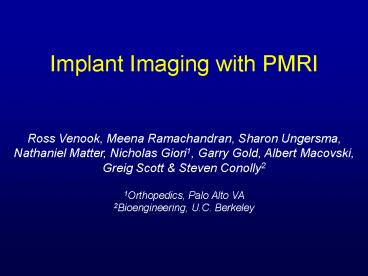Implant Imaging with PMRI - PowerPoint PPT Presentation
1 / 29
Title:
Implant Imaging with PMRI
Description:
Title: Autotuning Interventional Coils for Imaging Author: Ross Venook Last modified by: pmri Created Date: 4/9/2003 8:20:03 AM Document presentation format – PowerPoint PPT presentation
Number of Views:88
Avg rating:3.0/5.0
Title: Implant Imaging with PMRI
1
Implant Imaging with PMRI
Ross Venook, Meena Ramachandran, Sharon Ungersma,
Nathaniel Matter, Nicholas Giori1, Garry Gold,
Albert Macovski, Greig Scott Steven Conolly2
1Orthopedics, Palo Alto VA 2Bioengineering, U.C.
Berkeley
2
Outline
- Motivation
- Why should we image implants?
- Background on Implants
- Susceptibility
- Imaging Experiments
- Conclusion
3
Implantsso hot right now
- 300,000 total knee replacements per year
- 40-50 of orthopedic surgeries result in a
patient with some metal inside - All trauma, joint replacement, or spine
- Half of hand or foot
4
Why image implants? (short term)
- Post-operative evaluation is limited to
traditional radiographs - No soft-tissue imaging modality to track progress
or identify complications
5
Why image implants? (long term)
- Loosening is a longer-term complication
- Septic loosening gt Removal
- Immediate surgery, serious risks
- Loss of function
- Aseptic loosening gt Revision
- Lower risks
- Restores function
- Average implant age increases as people live
longer and as younger people get more implants
6
Outline
- Motivation
- Background on Implants
- Show and Tell
- Orthopedic methods, materials, manufacturers
- Problems with imaging implants
- Susceptibility
- Imaging Experiments
- Conclusion
7
Show and Tell
8
Orthopedic Methods
- Once involved mostly screws and plates
- Still used for traumatic cases, vertebrae
- Now working with bone cements, and special
surface geometries - Certain surface features promote bone adhesion
- Previously very few sizes/shapes of implants
- Now implants are modular for optimal size and
shape to match anatomy
9
Manufacturers and Materials
- Zimmer
- Alphatech
- Synthes
- Smith Nephew
- DePuy (J J)
- Howmedica (?)
- Others
- Stainless Steel
- Cobalt-chrome
- Titanium
- Titanium alloys
- Tivanium
- Zirconium
- Zirconium alloys
- Oximium
- Zimalloy
Optimized for safety and efficacy
10
Problem with Imaging Metal Implants is
they are made of metal.
- Radiography works fine
- Soft tissue somewhat lacking
Cyteval, et al., Rad 2002
11
Why not use CT?
- People do
Cyteval, et al., Rad 2002
12
Why not use CT?
- but there are problems
- Beam hardening
- Streaking artifacts
- Unable to differentiate aseptic loosening
Cyteval, et al., Rad 2002
13
Why not use MR?
- Short answer MR is just so darn sensitive
- Jonghos talk
- Lung air susceptibility
- B0 changes 1Hz
- Air has 9 ppm shift
- More than 1 radius from lungs
- Titanium has 180 ppm shift
- Image right on top of it
14
(No Transcript)
15
Outline
- Motivation
- Background on Implants
- Susceptibility
- Basics
- Why PMRI
- Imaging Experiments
- Conclusion
16
Susceptibility Basics
- All materials have mr
- Magnetic permeability
- Magnetic analog of electric polarizability
- Susceptibility defined
- c mr 1
- How susceptible to applied magnetic field
17
Susceptibility Wide Range
Schenck, JF, Med Phys 1996
18
Susceptibility in an MR Magnet
- Off-resonance artifacts depend on
- Orientation of object with respect to B0
- Magnitude of B0 (ppm)
- Susceptibility difference
- Dcci-ce
Ludeke, et al., MRI 1985 Butts, et al., JMRI 1999
19
Susceptibility in an MR Magnet
- Creates an object-dependent, orientation-dependent
, serious off-resonance artifact - DwDcgB0/2 (for right cylinder)
- a Dcw0
Materials Dc (ppm)
HbO2, dHb Air, Water Water, Titanium 0.3 9 180
20
Susceptibility Wrap-up
- As complicated as you want it to be
- Trajectory
- Readout Gradient Strength
- Slice Selection (RF and Gradient)
- Problems a DcgB0
- Material properties Dc, g
- Scanner property B0 (if only we had a
low-field)
Woohoo!
21
Outline
- Motivation
- Background on Implants
- Susceptibility
- Imaging Experiments
- PMRI (27mT) vs. 1.5T Spin Echo
- Conclusion
22
Goals
- Compare standard spin-echo images
- 1.5T Signa scanner (64MHz)
- TE 10ms, 31.25 kHz BW, 256x128, 24cm FOV, 3mm
slice - 27mT PMRI scanner (1.1MHz)
- TE 6ms, 16 kHz BW, 128x128, 12cm FOV, 1cm
slice - Simple experiment with actual implant
- Titanium tibial knee joint replacement
23
Images
1.5T, Signa
27mT, PMRI
24
Images
1.5T, Signa
27mT, PMRI
25
Images
1.5T, Signa
27mT, PMRI
26
Outline
- Motivation
- Background on Implants
- Automatic Tuning
- Imaging Experiments
- Conclusion
- Wait a minute
- Future work
27
Techniques for 1.5T
- View Angle Tilting (VAT)
- Re-registers water-fat and other inhomogeneities
- Presumes good slice
- Some blurring
- MARS
- VAT with bigger gradients
- VAT deblurring
- Kim, John, Garry
- Quadratic-phase RF
Standard SE
with MARS
Olsen, et al., Radiographics 2000
28
Future Work
- Image every implant in our collection
- Catalog artifacts at low-field
- Do susceptibility artifacts scale with field?
- Compare with 0.5T, 1.5T
- Compare with different PMRI fields (1MHz-2MHz)
- Other artifacts
- RF eddy currents
- Gradient switching
- Optimal field?
29
Acknowledgements
- GE Medical Systems
- NIH
- Nick Giori (implants)































